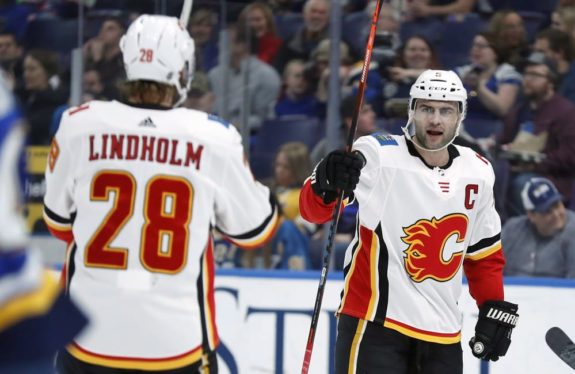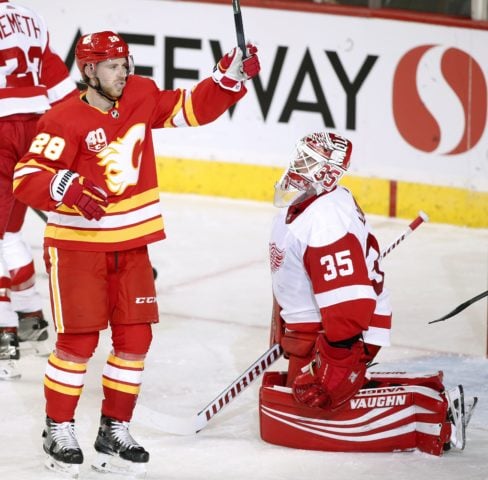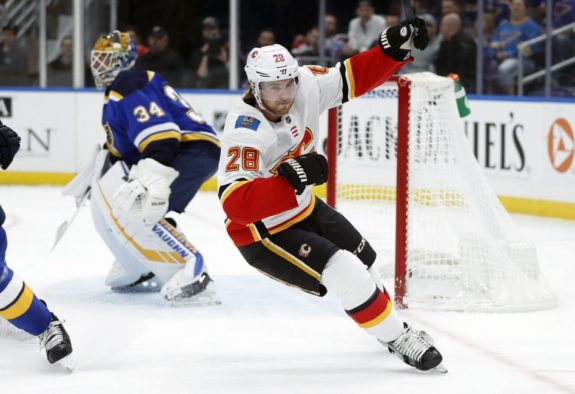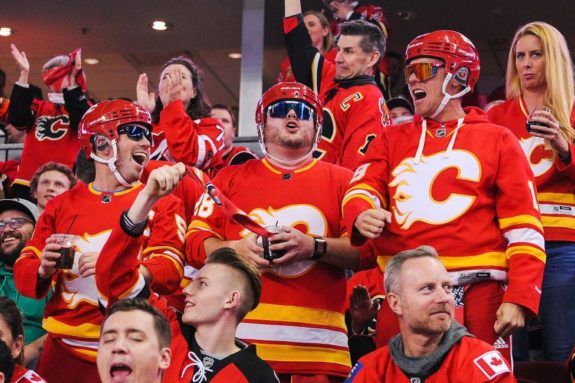
 Daniel Rosenke
The Hockey Writers
Daniel Rosenke
The Hockey Writers
29
Reads
0
Comments
Dissecting the Flames’ Lack of High-End Offence This Season
The Calgary Flames relatively poor offensive production in the 2019-20 campaign has left both fans and sports journalists mystified – perhaps rightfully so. Notwithstanding several minor moves in the offseason – namely the James Neal – Milan Lucic swap and the addition of Cam Talbot in a backup goaltending role – last season’s roster has remained largely intact.
Several explanations for the team’s regression have been tendered, most notably a post-playoff hangover after last season’s first-round exit courtesy of the Colorado Avalanche. Disappointments like that tend to have a negative impact on team morale. The question remains, can that alone account for the drastic decline in the Flames’ offensive production this season?
The simple answer is, likely not. Following an auspicious 2018-19 season during which the breakout Flames amassed 107 points, captured the Pacific Division crown, and tallied a whopping 289 goals (3.52 goals/game), the team has since struggled to find the back of the net. In contrast to its provincial rivals to the north – whose stars Connor McDavid and Leon Draisaitl are currently ranked first and second in league scoring, respectively – a sharp decline in production from the Flames’ lead protagonists accounts for the lion’s share of this season’s decline in offensive output.
Statistics Don’t Lie
From a purely statistical standpoint, the beloved “Johnny Hockey” Gaudreau, his loyal sidekick Sean Monahan, sophomore Flame Elias Lindholm, budding star Matthew Tkachuk, and last year’s Norris Trophy winner Mark Giordano have all underperformed relative to the 2018-19 regular season. For the sake of this discussion, I will refer to these star players as “The Big Five.”

After 50 games, the Flames have scored only 130 goals and averaged 2.60 goals/game, ranking the former offensive juggernaut just 23rd among NHL teams. With essentially the same roster as last season – notwithstanding several minor moves in the spring and summer months – the Flames goal production has decreased by a staggering 30 percent. That’s right, by nearly one-third. At this point a year ago the Flames had already scored 187 goals; an average of 3.74/game. By my expert calculations that totals 57 more than this season.
Disillusioned Flames fans searching for answers need not look further than the team’s high-end players. The Big Five have tallied 45 fewer goals than last season, accounting for a staggering 79% of the team’s decline in goal output. Incidentally, at the 50-game mark last season, Gaudreau, Monahan, Lindholm, Tkachuk, and Giordano were all ranked in the top-30 in league scoring. A year laterl, the Flames top point producers, Tkachuk (38) and Gaudreau (38), have barely managed to crack the top-60.
The Analytics Side
Modern day hockey analytics might help shed some light on this offensive shortfall. In 2018-19 the Big Five had an average Corsi-For rating (a measure of scoring chances for versus scoring chances against at even strength) of 55.6 (or 5.6% above the league average), which has fallen considerably to 52.0 this season. Fenwick rating (a team’s control of the puck when a player is on the ice) is also a worthy consideration here.
Thus far in the 2019-20 campaign, the Big Five have posted an aggregate Fenwick statistic of 50.7, down from 54.5 last season. In essence, this means when one or more amongst Gaudreau, Monahan, Lindholm, Tkachuk and Giordano have been on the ice this season, opposing teams have, on average, held the puck for approximately the same time duration. Rest assured, any NHL player would attest to the fact that puck possession is a key variable in producing offence.
Mediocrity to the Power of Five
Notwithstanding several minor moves in the off-season, the Flames roster remained largely intact leading into 2019-20. The Big Five are still here. Gaudreau, Monahan, and Lindholm were expected to pick up where they left off last season; shelling opposing teams on a nightly basis. Tkachuk was poised for a breakout season, and has assumed a greater leadership role within the team. And Giordano? Perhaps one could attribute his lackluster offensive production to age, but that might be a stretch.
At this point last season, the Flames captain had already amassed 50 points (6 goals and 29 assists) and was carrying a plus-20 rating. Presently the 37-year-old is sitting at just 22 points and an even plus/minus rating. Can such a considerable decline in production be wholly explained by the fact he’s a year older? I think not.

Suffice to say, the Flames’ season hitherto has been a disappointment for fans, whose expectations were sky-high after the team’s prodigious 2018-19 campaign. The aforementioned statistics are self-explanatory, but fail to provide a serviceable explanation for the team’s dramatic decline in offensive output. Have opposing teams found a magic formula to extinguish the Flames’ high-powered offence (pun intended)? Even the most casual of fans might scoff at the notion.
As hockey fans, our tendency is to employ an Occam’s Razor-like rationale to irreconcilable situations like these. It’s human nature. The simplest and most digestible explanation is often correct, right? Disillusionment from an early-round playoff exit last season? Pressure to perform after an auspicious 2018-19 regular season? Maybe.
The problem here is quantifying and measuring these psychological variables in individual players, and their impact on the performance of the team as a whole. In reality, we’re more likely to see a Lucic hat trick than a scientific study like that. While players’ mindsets could be an underlying factor here, there is no evidence pointing to a cause-effect relationship in that respect. It is little more than conjecture.
The fact remains, the Big Five have accounted for a whopping 79% of the Flames’ decline in offence this season. Was last season a fluke? Can this season be considered a regression to the mean? Could a confluence of factors, tangible or otherwise, have resulted in the relative lack of production from the team’s big guns in 2019-20? Perhaps. Let’s delve in shall we?
High-Danger Scoring Chances
Infiltrating the tough areas, taking punishment, and getting the puck to the net is no easy task. After 50 games the Big Five have accrued 143 high-danger scoring chances (HDCF) for, down 26% from 194 at the same point last season. Fewer scoring opportunities typically means fewer goals. It should be noted that Gaudreau-Monahan-Lindholm, the Flames’ homage to the Philadelphia Flyers “Legion of Doom” line of the 1990s, have totaled 55 fewer HDCF compared to last season. It comes as no surprise that the trio’s aggregate shooting percentage has dropped from 14.8 to 11.1. While Lindholm has regained a semblance of his 2018-19 form on the Flame’s second unit as of late, his numbers pale in comparison to last season’s.

Chalk it up to complacency, unfavorable puck-luck, or last year’s disappointing first-round exit, if that comforts you. The reality is most seasoned coaches tend to attribute such a drastic decline in scoring chances – at least in part – to players staying on the periphery; unwilling to fight for position around the net. Relative to this time last season the Flames are averaging approximately 0.6 fewer shots on goal per game (31.4 versus 32.0), and its Big Five have averaged one fewer HDCF per game. There’s some food for thought.
The Plight of Johnny Hockey
After posting career highs in goals (39) and points (99) in 2018-19, the Flames’ franchise player has plummeted back to Earth. With a paltry 38 points – down from 73 points at the 50 game mark last season – and a -14 plus/minus rating, Gaudreau’s on-ice frustration has been palpable this season. Considering he’s scoring points at barely half the rate of last season, this should come as no surprise.
Regardless, as a veteran player and the team’s offensive leader it is imperative that Gaudreau exude positivity and confidence. The former Lady Byng winner’s mediocrity has also had a ripple effect. As the Robin to Gaudreau’s Batman, Monahan is on pace for his worst statistical season since his rookie campaign in 2013-14. Should Gaudreau’s poor production and hang-dog attitude persist, the boys in red will be hard-pressed to secure a playoff berth come April.
The Honeymoon Phase Is Over
The addition of Lindholm last season seemed to be just what the doctor ordered; both for the Swede and the team as a whole. In 2018-19 Lindholm eclipsed his previous career bests in nearly every offensive category, but has cooled off significantly in his sophomore campaign with the Flames.

As is the case in some (or arguably most) romantic relationships, there seems to have been a gradual decline in chemistry with Gaudreau and Monahan. It should be noted, however, that chemistry has yet to make its way into the hockey analytics milieu. Keep in mind, in Lindholm’s first season as a Flame, Gaudreau and Monahan also produced career-best numbers. While his play has been more inspired after taking on second-line duties alongside Tkachuk, Lindholm’s overall offensive output and lack of consistency have left something to be desired.
An Evidence-Based Framework
Suffice to say, relative to 2018-19 the Flames goal output thus far has been nothing short of abysmal. While convenient rationalizations like the aforementioned “playoff hangover” might serve to mollify the average fan, they are far from measurable. Ironically, NHL journalists and fans have welcomed the analytics era with open arms, yet still take stock in these ill-conceived, intangible, and dare I say asinine, explanations. By default, “the playoff hangover”, for example, serves as an instructive placeholder for those searching for answers. “The Flames offence has been abysmal this season… my God… well, in the absence of any logical reason, it must be reason X,” said the docile fan.

The reverse scenario holds equal merit. Had the Flames come roaring out of the proverbial gates to start the season, fans could just as readily have cited the early playoff exit as a motivating or galvanizing force. The popular and now colloquial precept correlation does NOT equal causation is pertinent here. The point is that ascribing the quality of an outcome – in this case the Flames lackluster offensive production – to some kind of nebulous, ill-defined, and apparently chronic psychological lull from the spring is wholly unscientific, and perhaps even lazy.
Just as general managers have utilized analytics to assess the true value of players, so too must fans adopt an evidence-based approach in matters like these, and lay to waste the armchair fan hubris that has pervaded for decades. The ever-popular and nonsensical “puck luck” rationalization also holds little merit, yet is regularly expounded by so-called hockey experts and die-hard fans. Whether it be a function of national pride, pure and simple ignorance, or something in between, I still believe we as Canadian hockey fans are better than that. Indeed, explanations like “the playoff hangover” cannot account for the considerable decline in offence the Flames have experienced this season; both for the team as a whole, and its Big Five.
The post Dissecting the Flames’ Lack of High-End Offence This Season appeared first on The Hockey Writers.
Popular Articles

















































 Blackhawks Chicago
Blackhawks Chicago Panthers Florida
Panthers Florida Penguins Pittsburgh
Penguins Pittsburgh Rangers New York
Rangers New York Avalanche Colorado
Avalanche Colorado Kings Los Angeles
Kings Los Angeles Maple Leafs Toronto
Maple Leafs Toronto Bruins Boston
Bruins Boston Capitals Washington
Capitals Washington Flames Calgary
Flames Calgary Oilers Edmonton
Oilers Edmonton Golden Knights Vegas
Golden Knights Vegas Flyers Philadelphia
Flyers Philadelphia Senators Ottawa
Senators Ottawa Lightning Tampa Bay
Lightning Tampa Bay Red Wings Detroit
Red Wings Detroit Islanders New York
Islanders New York Sabres Buffalo
Sabres Buffalo Devils New Jersey
Devils New Jersey Hurricanes Carolina
Hurricanes Carolina Blue Jackets Columbus
Blue Jackets Columbus Predators Nashville
Predators Nashville Stars Dallas
Stars Dallas Jets Winnipeg
Jets Winnipeg Wild Minnesota
Wild Minnesota Blues St. Louis
Blues St. Louis Mammoth Utah
Mammoth Utah Ducks Anaheim
Ducks Anaheim Sharks San Jose
Sharks San Jose Canucks Vancouver
Canucks Vancouver






